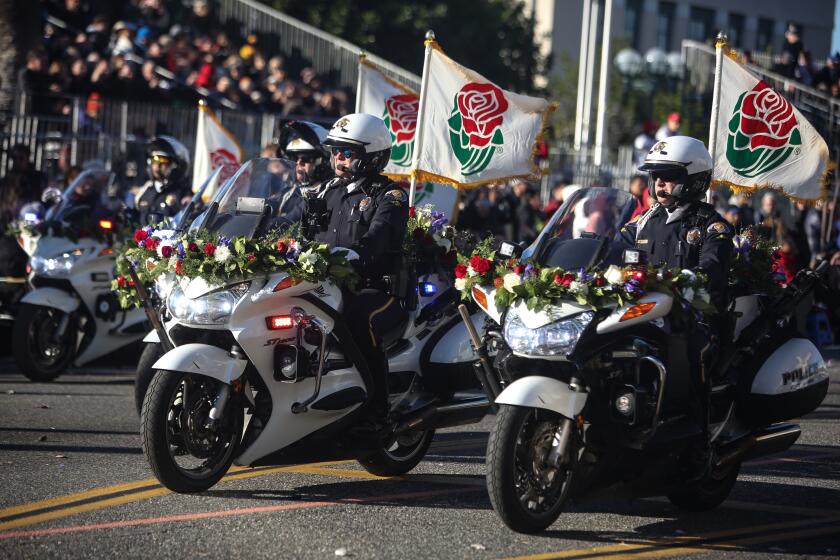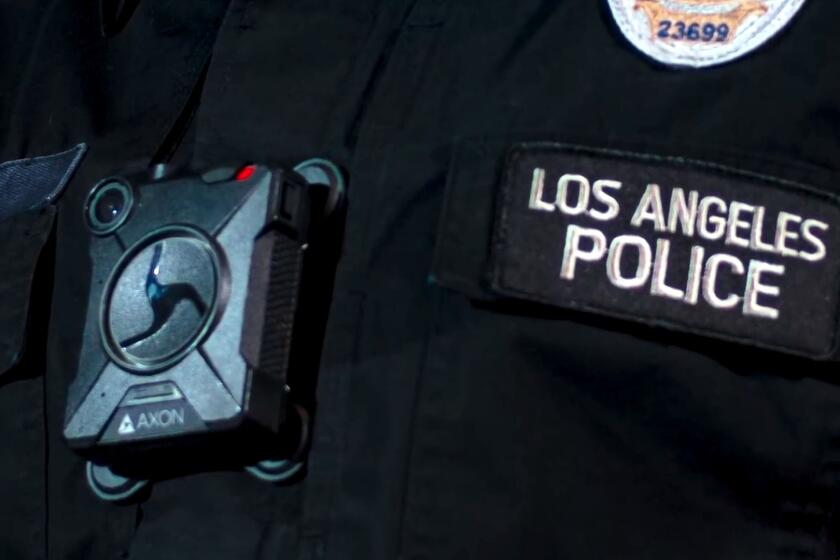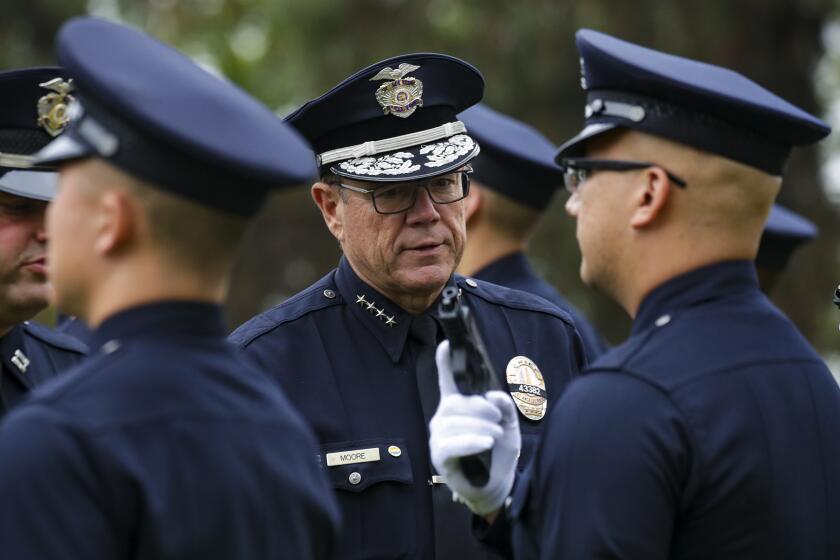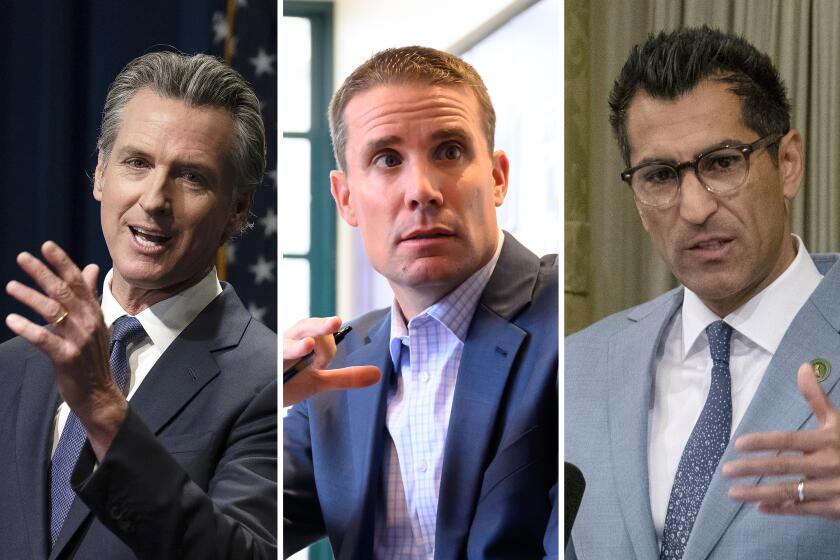A CHP officer shot him 12 times. But with no body cameras, truth is elusive

- Share via
The sound of more than a dozen rapid-fire gunshots sent Angela Rivera running down her street.
It was about 2:30 a.m. and moments earlier, her son had driven by while being pursued by several California Highway Patrol cruisers.
When Rivera reached the source of the gunfire, she realized her 21-year-old son Sei-Jah Rivera was mortally wounded by a dozen gunshots from a lone CHP officer. Three other officers chasing Rivera did not fire their weapons, but authorities say Rivera had pulled a gun and the shooting officer perceived he was under immediate threat.
While there is CHP dashcam footage from that morning of Feb. 26, the shooting itself isn’t captured on camera. That’s because, experts say, the CHP had, until recently, been stubbornly slow in deploying body cameras within its ranks.
“There is no reason in this day and age, when the camera technology is so readily available, to not have body-worn cameras on officers in the field,” said Geoffrey Alpert, a professor of criminology and criminal Justice at the University of South Carolina.
Over the last decade, law enforcement agencies in California and across the nation have gradually integrated body-worn cameras into their operations. A study from 2016 estimated nearly 80% of large law enforcement agencies had acquired body-worn cameras, according to the Bureau of Justice Statistics, and since then additional local agencies have followed suit.

The Riverside County Sheriff’s Office set rules for its body-worn cameras in 2016, the Los Angeles County Sheriff’s Department began budgeting for them in 2020, and San Bernardino County began providing them to deputies last year.
But the CHP is only beginning to catch up.
In 2022, the CHP had about 7,600 officers, but only 3% of them — or about 240 — were equipped with body-worn cameras, according to reporting from CalMatters.
Currently, about 1,500 CHP officers have them — but they’re all located in the Sacramento Valley and Bay Area, a department spokesperson said.
The state Legislature approved $9.9 million in the 2024/2025 budget to purchase body-worn cameras for the CHP and $4.9 million for ongoing costs, but the equipment has not yet been deployed and training is underway.
CHP officers in Southern California should begin receiving body-worn cameras in the next six to eight weeks, but that’s little consolation for Rivera’s family.
“The State’s refusal to date to equip CHP officers with BWCs [body-worn cameras] will make our job harder but not impossible,” the family’s attorney David Fiol said.
On May 14, the family filed a wrongful-death lawsuit against the CHP. The agency declined to comment on pending litigation.
“Because we can’t rely solely on the statements of the four officers at the scene, and Mr. Rivera can not provide his version of events, we are working with qualified experts to scrutinize the objective evidence we do have,” Fiol said, “including the dashcam video and audio and the coroner’s report, to reconstruct the moments before the defendant began shooting.”
The new technology considered by the Pasadena Police Department would activate body cameras when an officer draws a gun.
On Feb. 26, Sei-Jah Rivera was driving his father’s work van when the CHP said he ran a red light and then refused to stop. At the time, Angela Rivera didn’t realize it but she was watching the pursuit unfold as she tracked her son’s location with a phone app, waiting for him to come home from a night out with his cousins.
Within minutes, she watched her son’s location pass by their home with the sound of blaring sirens. CHP dashcam videos provided to the family show what transpired from there:
Rivera drove to the end of a cul de sac and tried to turn around, but a CHP officer rammed into the side of the van, incapacitating it.

A CHP officer ordered Rivera to shut off the engine and get out.
“Hey, turn it off. Turn it the f— off. Turn it the f— off.” the officer shouted. “Hey, turn it off or you’re going to get shot!”
Rivera got out of the van as two nearby CHP officers reached out unsuccessfully to grab him.
Rivera then ran behind the van where he could not be seen by the dashcam, but the audio is clear.
Someone is heard shouting “gun! gun! gun! gun! gun!” then an officer is seen unloading his firearm at Rivera. One officer is heard yelling “stop! stop!” several times before the shooting concludes.
Then, someone says, “He threw it. He threw it over the fence.”
According to the family’s lawsuit, Rivera got out of the vehicle, “trotted toward the end of the street, removed the gun from his waistband, and tossed it over an eight-foot cinder block wall.”
The family claims in their lawsuit that Rivera had his back to officers when he tossed his gun over the fence, then surrendered. The complaint claims the officer fired 16 times and “continued to shoot even after Sei-Jah raised his empty hands as a sign of submission,” though it does not specify what that account is based on.
According to the autopsy, Rivera was struck by 12 rounds, including several that hit him in the back and left shoulder and one that entered the back of his head. Officers rendered aid at the scene but Rivera died of his wounds, according to the report.
The autopsy report notes also that Rivera’s handgun was recovered at the scene.
Angela Rivera said she rushed to the scene, but was turned away by officers.
“I just wanted to give him one last hug, but they pushed me away like an animal,” she said
The Los Angeles Police Department is considering changing department policy to increase random reviews of body camera recordings.
The Times showed the dashcam footage to use-of-force experts who independently reviewed the footage. They agreed that it’s difficult to make out the exchange that led to the shooting, because the van obscures the view.
“We’re not going to ask an officer to risk his life by saying, ‘Oh, I wonder if he’s trying to get rid of the gun or he’s going to shoot me,’” said Ed Obayashi, a deputy sheriff in Modoc County and a law enforcement policy advisor to police agencies across the state. “The officer would have been justified in feeling that there was an immediate threat to his life and his other officers, regardless of the subject’s intentions.”
It’s unclear what caused the officer to shoot, but it’s reasonable to assume that Rivera pulled out a gun when he was on the other side of the van, based on the sequence of events, Obayashi said.
He added that it’s not unusual for officers to fire multiple times in a matter of seconds in such scenarios and, in the absence of bodycam footage, investigators will have to rely heavily on officer statements and what threats they perceived, while determining why only the one officer fired. It’s unclear what the field of vision looked like for the officers who did not fire, Obayashi said, but they may have been concerned about hitting the officer if they opened fire when he was so close to Rivera.
The incident is being investigated by an outside law enforcement agency, as is standard protocol for officer-involved shootings in California.
Jerry Rodriguez, a retired 35-year law enforcement officer and expert witness, said the position of Rivera’s gun plays a role in how the shooting officer responded.
“He fired 16 rounds, and we’re accountable for every round that we discharge,” Rodriguez said. “So, in order to assess the objective reasonableness of that, you would have to be able to discern what threat was being posed to the officer at the time.”
Internal LAPD reports indicate the problem of police officers flouting department body camera policy is more widespread than officials have been telling the public.
According to the Los Angeles County Medical-Examiner’s autopsy and toxicology reports, Rivera was 6 feet tall, 288 pounds and was under the influence of opiates when he was killed.
His family said he loved to sing and dance and had lost about 100 pounds over the past year as he worked toward his goal to join the U.S. Navy and his long-term aspiration was to become a firefighter.
“He was running every day and trying his best to get into shape,” his older brother, Okalani Langi, said.
Fiol, the family attorney, said officers can’t justify shooting Rivera because of the mere sight of a gun. He pointed to a decision last year from the 9th Circuit Court of Appeals that ruled a San Jose police officer could stand trial in a 2019 fatal shooting involving a replica gun and was not protected by qualified immunity, a common shield from liability for law enforcement.
“The bottom line is the defendant shot at an unarmed man sixteen times,” Fiol said, suggesting Rivera had already tossed the gun when he was shot.
Alpert, the criminology professor, said the majority of the time body-worn cameras confirm an officer’s version of events. But there are cases where an officer’s report does not align with what the footage reveals, like when LAPD officers were found to be out of department policy when they repeatedly used a stun gun on a teacher in 2023 and the man later died.
That’s why the technology is important and should be embraced, said Alpert, the criminology professor.
“It becomes a moral compass issue,” he said. “Why would a police chief not want to have his officers equipped with cameras?”
More to Read
Sign up for Essential California
The most important California stories and recommendations in your inbox every morning.
You may occasionally receive promotional content from the Los Angeles Times.

















